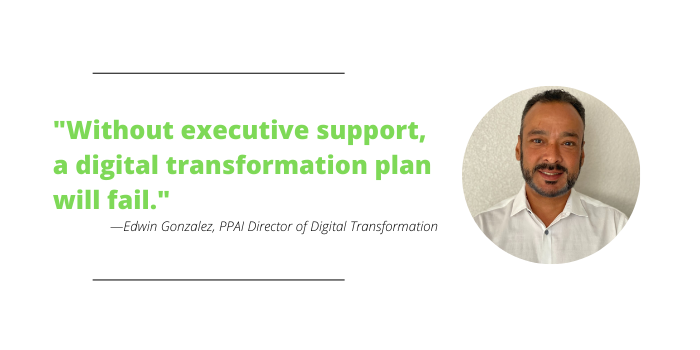Digital Transformation Goals Require Proper Planning And Executive Support

Having a digital transformation plan is essential to its proper execution and ensuing efficiency, but it’s also one of the greatest challenges for businesses new to digitization. Nearly half (49%) of executives don’t have a clear plan or goal for their digital initiatives, according to the findings of a recent survey.
The 2022 State of Digital Transformation, published in October by information services firm Modus Create, and which polled 1,006 directors and managers from private, for-profit, U.S.-based businesses, also found that 31% of organizations said they don’t believe that digital initiatives are critical to their futures. The survey cites this statistic as “a clear indication” of these companies’ “untapped potential.”
“Some companies that are performing well do not see a need to digitize their operations and are OK with assigning staff to manual processes or hiring more people,” says Edwin Gonzalez, PPAI’s director of digital transformation. “The concern is this is not sustainable as employee satisfaction goes down without the proper tools to do their jobs and prohibits them from growing and learning a new skill set.”
The findings of Modus Create align with the findings of “The Digital Divide,” a May 2021 poll from U.K.-based hybrid cloud firm Pulsant which surveyed 200 IT decision-makers and 200 business leaders from mid-sized companies in the U.K.. The Pulsant survey found the majority of IT decision-makers said their businesses had a clear vision for transformation (84%), but 11% said it was unplanned and ad-hoc, and an additional 11% said they had no idea how to get started—a finding that suggests some businesses may have a semblance of a plan, but one that’s loosely defined.

With so many traditional processes turning digital and with consumers demanding more of a digital presence and experience from companies, these survey findings beg the question as to why some companies are not seeing the benefits of digitization planning.
“The customer is impacted because manual processes are prone to human error and cause more work for the customer and the business, such as having to correct an invoice or a sales order,” Gonzalez says. “Other companies just don’t think it’s worth the investment as they may not see an immediate return-on-investment (ROI) or an ROI at all. However, there are ‘soft’ benefits in employee retention, customer satisfaction and overall efficiency in the business.”
Comparing small to large companies, the Modus Create survey showed that large businesses, engrossing more than $500 million a year in revenue, are more likely to see digital transformation as critical to their organizations (82%) compared with mid-sized companies (74%), engrossing $1-500 million a year,and small companies (57%) earning less than $1 million a year in revenue. However, Gonzalez says that in the promotional products industry, he is seeing that “smaller companies are more likely to have to involuntarily digitize to complete in this marketplace.”
Once a digital transformation plan is in place, Gonzalez says action starts at the top. “Without executive support, a digital transformation plan will fail. With proper support, it will inherently start with a strategic vision from company executives and trickle down to implementation teams and ultimately staff members.”
But even before executives begin to lead the charge, a digital transformation plan must be developed with a clear end goal in mind, whether that entails creating efficiencies, new products or both, Gonzalez says. “It starts with an IT uplift, meaning identifying technology that can digitize a process or save costs by moving to the cloud.”
Once a new technology is put in place, companies can then begin to digitize their operations and create efficiencies, Gonzalez says. This process follows with leveraging data, such as marketing or sales data, to inform processes with data-driven decisions. The end result, Gonzalez says, “should either drive a business to new products and service, better customer service, and employee satisfaction and retention.”

